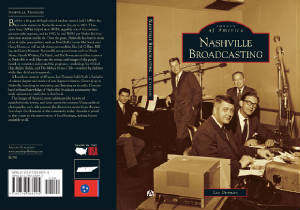|
|
 |
|

Nashville Broadcasting, by veteran broadcaster Lee Dorman, is available at all Nashville area bookstores, or online from this website. It is
part of Arcadia Publishing's Images of America series, and includes 214 photos depicting the growth of broadcasting
in Nashville. Radio stations which went on the air beginning in 1922 and television stations beginning in 1950 are included.
|
 |
|
| photo courtesy of WSM |

|
| "Jack" DeWitt, Jr. founded WSM in 1925 as well as Nashville's first station in 1922 |
Nashville has a rich broadcast history, beginning in 1922 with a radio station started by 16-year
old John "Jack" DeWitt, Jr. at Ward-Belmont School. Many other stations have come and gone since then. Some survive,
and have thrived over the years, including WLAC and WSIX, two of the other earlier stations in Middle Tennessee. Others have
long since departed the airwaves, such as the station owned and operated by the city's daily morning newspaper, the Nashville
Tennessean, appropriately designated WTNT, WBAW and WDAD, an offshoot of Dad's Auto Accessories in downtown Nashville.
This website will tell the stories of all of these stations, both radio and television, with a wealth of history and photos
which show the announcers, disc jockeys, news staffs and program hosts we listened to and watched as we grew up in Nashville.
|
 |

|
| Luke Lea, publisher of The Nashville Tennessean, started WTNT |
Wonderful
photos and a nostalgic look at the early days of Nashville television include
portraits of Channel 4 (WSM) with Jud Collins, Dave Overton, the Waking Crew and The Five O'Clock Hop; Channel 5 (WLAC) with
Bill Jay, Bob Lobertini and others; and Channel 8 (WSIX) with Noel Ball, Ken Bramming, Hudley Crockett and the ever-popular
Live Studio Wrestling.

WSIX
radio was originally a radio station located in Springfield, Tennessee. Started by the 638 Tire and Rubber Company, WSIX moved
to Nashville and eventually added an FM station and the television station which became the ABC afilliate. It changed its
call letters to WNGE and later to WKRN, and also moved from Channel 8 to Channel 2.
|
|
 |
Although
there were several radio stations in Nashville which went on the air before
WSM, the station owned by the National Life and Accident Insurance Company was the earliest broadcaster which is still on
the air today. Hitting the airwaves for the first time in 1925, WSM was to arguably become this city's most prominent and
successful radio station, joining the NBC network and originating the Grand Ole Opry, as well as going on to also become Nashville's
first television station.
| photo courtesy of WSM |

|
| Earliest photo of WSM'S Grand Ole Opry |
|
 |
The story of WSM,
the creation and rise of the Grand Ole Opry, how the station became known across the country and not just here at home, and
how and why it also became Nashville's first television station, is told on both the Radio and Television pages of this website.
Other interesting stories you will find include how, after National Life and Accident Insurance Company founded WSM, one of
its biggest competitors, Life and Casualty Insurance Company, decided to begin its own station and started WLAC; how WSIX
was started as an offshoot of the 638 Tire and Rubber Company in Springfield, then moved to Nashville; how Luke Lea, publisher
of the Nashville Tennessean newspaper decided he, too, wanted a radio station and put WTNT on the air; and the "radio
wars" between rock and roll giants WKDA ("Home of the Good Guys") and WMAK ("Home of the All-Americans")
in the late 1950's and early 60's.

|
|
|
|
Enjoy
what you see and read here, and feel free to make any suggestions if you think we have forgotten something important. We welcome
all contributions. If you have memories of stations, or personalities, you wish to share with others, send them to us. If
you have information you think would enhance our descriptions of radio and television stations, and their history, send them
to us. if you have questions, ask us. We want to hear from you. To e-mail us, simply click here.
|
|
|
 |

